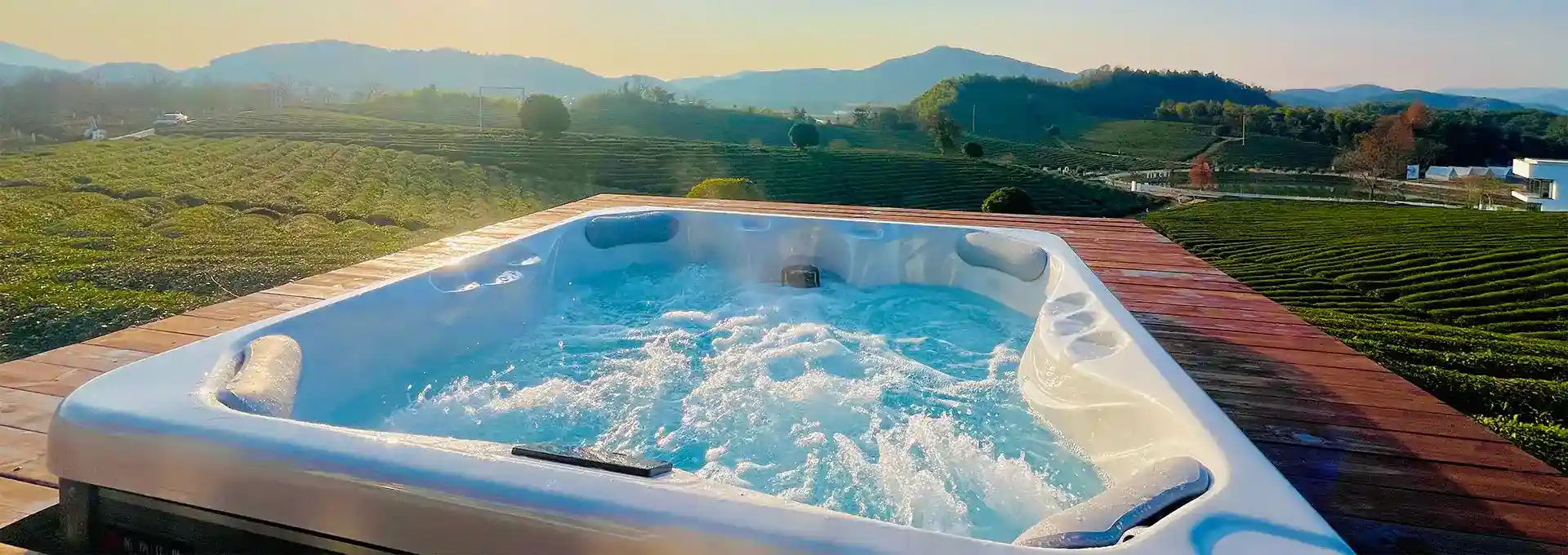Does a Swim Spa Add Value?
2024-10-10 09:20:22
A swim spa is a unique hybrid between a swimming pool and a hot tub, offering the best of both worlds in a compact package. As homeowners increasingly seek ways to enhance their property and lifestyle, many wonder if investing in a 7 person swim spa is worthwhile. The question "Does a swim spa add value?" is multifaceted, encompassing not just financial considerations but also lifestyle improvements and personal enjoyment. In this blog post, we'll explore the various aspects of swim spa ownership and its potential to add value to your home and life.
What are the benefits of a swim spa compared to a traditional pool?
Swim spas offer a range of benefits that set them apart from traditional swimming pools, making them an attractive option for many homeowners. One of the most significant advantages is their compact size. Unlike full-sized pools that require extensive yard space, swim spas can fit into smaller areas, making them ideal for urban homes or properties with limited outdoor space. This space-saving feature doesn't compromise functionality; swim spas still provide ample room for swimming, exercising, and relaxation.
The versatility of swim spas is another key benefit. They combine the features of a pool and a hot tub, allowing users to enjoy both swimming and hydrotherapy in one unit. The adjustable current in swim spas enables users to swim in place, providing an excellent workout without the need for lap swimming. This feature is particularly appealing to fitness enthusiasts and those seeking low-impact exercise options.
Maintenance is often a concern with traditional pools, but swim spas offer a more manageable solution. Their smaller water volume means less chemical treatment is required, and the enclosed design helps keep debris out, reducing cleaning time. Many 7 person swim spas come with advanced filtration systems that further simplify maintenance.
Energy efficiency is another area where swim spas shine. Their smaller size and better insulation make them more cost-effective to heat and maintain at a comfortable temperature year-round. This energy efficiency not only reduces operating costs but also extends the usability of the spa throughout the year, even in colder climates.
The installation process for swim spas is generally less invasive and time-consuming compared to in-ground pools. Many models can be installed above ground or partially in-ground, offering flexibility in placement and potentially reducing installation costs. This easier installation also means that swim spas can be a viable option for renters or those who may move in the future, as they can potentially be relocated.
From a therapeutic perspective, swim spas offer numerous health benefits. The combination of swimming and hydrotherapy jets provides a full-body workout and relaxation experience. The warm water and jet massages can help alleviate muscle tension, improve circulation, and reduce stress. For individuals with joint issues or those recovering from injuries, the low-impact exercise environment of a 7 person swim spa can be particularly beneficial.
Lastly, swim spas can serve as a social hub for family and friends. Their intimate size encourages conversation and connection, making them perfect for small gatherings or family time. The ability to use the spa for both active exercise and relaxation means it can cater to different preferences and age groups, enhancing its value as a family-friendly addition to the home.
How much does a swim spa cost to install and maintain?
The cost of installing and maintaining a swim spa is a crucial factor for homeowners considering this investment. Initial costs can vary widely depending on the model, size, and features of the swim spa, as well as the installation requirements of your specific property.
On average, the purchase price of a swim spa can range from $20,000 to $50,000 or more for high-end models. This initial investment covers the spa unit itself, which typically includes the shell, pumps, heaters, and basic features. However, it's important to note that this is just the starting point of the total installation cost.
Installation expenses can add significantly to the overall cost. Factors that influence installation costs include site preparation, electrical work, and any additional landscaping or decking required. If you're installing the swim spa in-ground or partially in-ground, excavation costs will also come into play. On average, installation can add anywhere from $5,000 to $15,000 or more to the total cost, depending on the complexity of the project and local labor rates.
For those considering financing options, many dealers offer payment plans that can make the initial investment more manageable. It's worth exploring these options and calculating the long-term costs, including interest, when budgeting for your 7 person swim spa.
Once installed, ongoing maintenance costs are an important consideration. While generally lower than those of traditional pools, swim spa maintenance still requires a financial commitment. Monthly operating costs typically include electricity for heating and running pumps, water treatment chemicals, and occasional professional servicing.
Electricity costs can vary based on your local energy rates, climate, and usage patterns. On average, homeowners might expect to spend between $50 to $150 per month on electricity for their swim spa. This cost can be higher in colder climates or if the spa is used frequently.
Chemical costs for maintaining proper water balance and sanitation are another ongoing expense. Monthly chemical costs typically range from $20 to $50, depending on the size of the spa and how often it's used. Many swim spa owners choose to invest in an automatic chemical feeder or saltwater system, which can simplify maintenance and potentially reduce long-term chemical costs.
Regular maintenance tasks such as cleaning filters, checking water chemistry, and performing minor repairs can often be handled by the owner. However, it's recommended to have a professional service the swim spa at least once a year. This annual service can cost between $200 and $500, depending on the extent of the maintenance required.
It's also wise to budget for potential repairs or replacement of components over time. While high-quality swim spas are built to last, parts like pumps, heaters, or covers may need replacement after several years of use. Setting aside a small amount each month for these eventual costs can help manage the long-term financial impact.
When considering the total cost of ownership, it's important to factor in the potential energy savings compared to a traditional pool. Swim spas generally use less energy due to their smaller volume and better insulation, which can lead to lower operating costs over time.
While the costs associated with installing and maintaining a 7 person swim spa are significant, many owners find that the benefits in terms of health, lifestyle, and potential property value enhancement justify the investment. By carefully budgeting for both upfront and ongoing costs, homeowners can make an informed decision about whether a swim spa is a worthwhile addition to their property.
Can a swim spa be used year-round in all climates?
One of the most appealing aspects of swim spas is their potential for year-round use, even in varying climates. This feature sets them apart from traditional outdoor pools and significantly enhances their value proposition for many homeowners. However, the extent to which a swim spa can be used throughout the year depends on several factors, including the climate, the spa's design, and the owner's willingness to maintain it during colder months.
In moderate climates, swim spas can indeed be used comfortably throughout the year with minimal additional effort. Their smaller water volume compared to traditional pools means they're easier and more cost-effective to heat, allowing for comfortable use even when air temperatures drop. Many swim spas are designed with excellent insulation and energy-efficient heating systems, which help maintain water temperature without excessive energy consumption.
For colder climates, swim spa manufacturers have developed models specifically designed for year-round use in harsh winter conditions. These units often feature reinforced insulation, powerful heating systems, and freeze protection mechanisms. Some high-end models even incorporate additional features like automatic freeze protection, which activates pumps and heaters to prevent water from freezing in the plumbing system during extremely cold weather.
The use of thermal covers is crucial for maintaining water temperature and reducing heat loss, especially in colder months. These covers are typically included with 7 person swim spas and are designed to fit snugly, trapping heat and preventing evaporation. Some advanced models feature automatic cover systems that can be easily deployed, encouraging regular use even in chilly weather.
In regions that experience snowfall, swim spa owners often create winterized enclosures or shelters around their spas. These can range from simple windbreaks to more elaborate structures like retractable domes or permanent gazebos. Such enclosures not only protect the spa from snow and ice but also create a more comfortable environment for users, extending the usable season even in the harshest winters.
For those living in extremely cold climates, some additional considerations may be necessary. This might include installing additional heating elements, using thermal blankets, or even incorporating hot water top-up systems to maintain comfortable water temperatures. While these measures may increase energy consumption, many users find the ability to enjoy their swim spa year-round worth the additional cost.
It's worth noting that year-round use in hot climates presents its own set of challenges. In regions with extremely high temperatures, swim spa owners might need to focus on cooling rather than heating the water. Many modern swim spas come equipped with cooling systems or can be fitted with chillers to maintain comfortable water temperatures during hot summer months. Additionally, features like shade structures or strategic placement in naturally shaded areas can help manage water temperature in hot climates.
The ability to use a swim spa year-round not only enhances its value as a lifestyle addition but also potentially increases its impact on property value. A feature that can be enjoyed regardless of the season is often more attractive to potential buyers, should you decide to sell your home in the future.
Maintenance practices may need to be adjusted based on the season and climate. In colder months, more frequent checks of the heating system and water chemistry might be necessary. Conversely, in warmer months, increased attention to sanitation and algae prevention may be required due to higher water temperatures and more frequent use.
While swim spas can generally be used year-round in most climates, it's important for potential buyers to consider their specific geographical location and personal comfort preferences. Consulting with local 7 person swim spa dealers or owners in your area can provide valuable insights into the practicalities of year-round use in your specific climate.
In conclusion, the year-round usability of swim spas significantly contributes to their value proposition. With proper design, insulation, and maintenance, these versatile units can provide enjoyment and health benefits throughout all seasons, making them a worthwhile investment for many homeowners, regardless of their climate.
For more information on hot tub installations and to find out more about our products, please feel free to contact us at info@iparnassus.com.
References:
1. Swim University. (2023). "The Ultimate Guide to Swim Spas."
2. HomeAdvisor. (2024). "How Much Does a Swim Spa Cost?"
3. Aqua Magazine. (2022). "The Growing Popularity of Swim Spas."
4. Pool and Spa News. (2023). "Year-Round Swimming: The Benefits of Swim Spas."
5. Energy.gov. (2024). "Energy Efficient Pool and Spa Systems."
6. HGTV. (2023). "Swim Spas: The Best of Both Worlds."
7. Realtor.com. (2024). "Does a Swim Spa Add Value to Your Home?"
8. Swim Spa Guide. (2023). "Maintaining Your Swim Spa in Different Climates."
9. Aquatics International. (2024). "The Rise of Swim Spas in Urban Environments."
10. Better Homes & Gardens. (2023). "Swim Spas vs. Traditional Pools: Making the Right Choice for Your Home."



